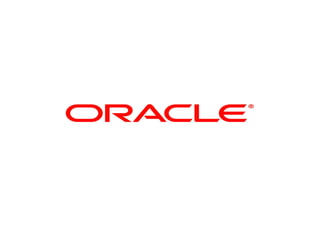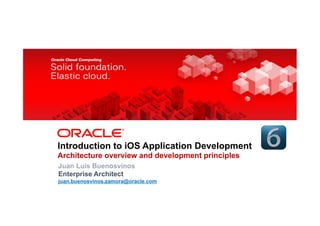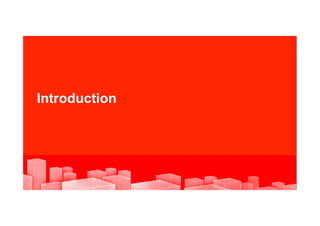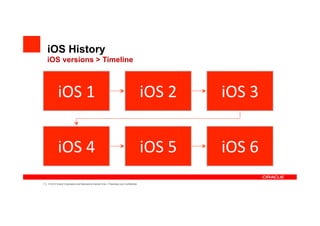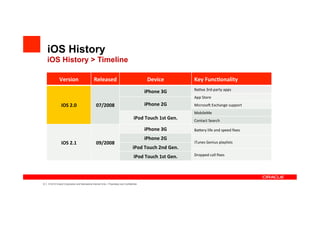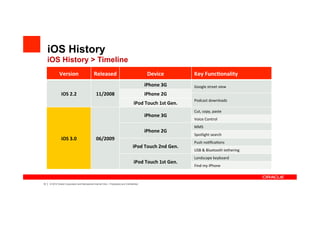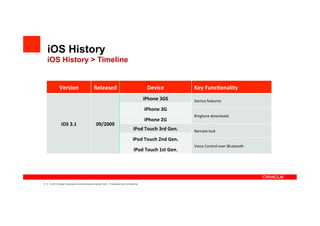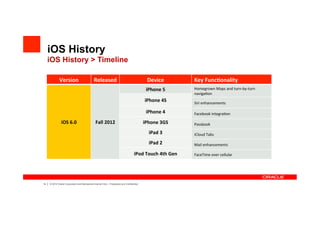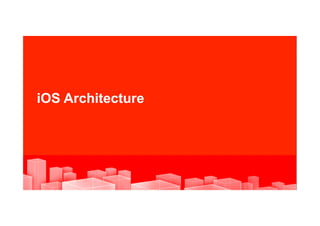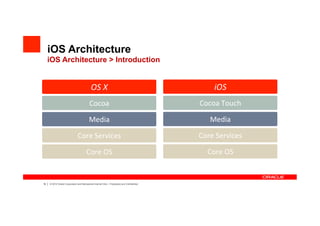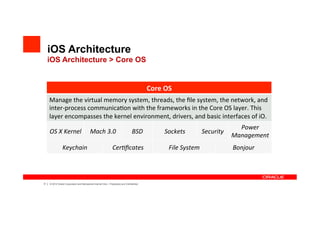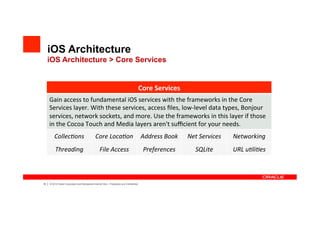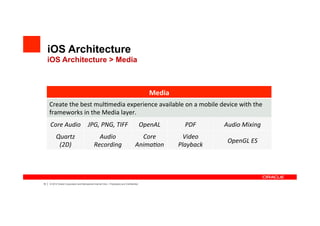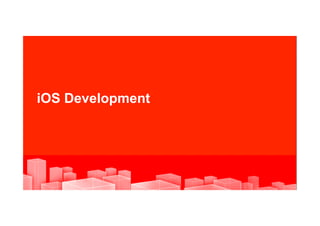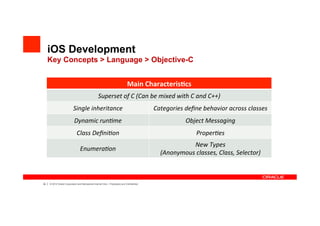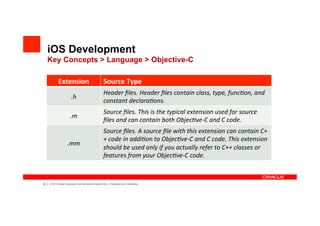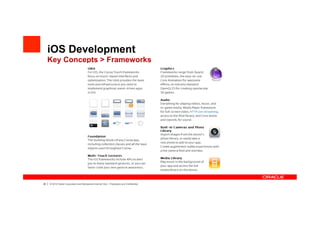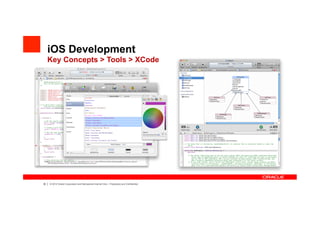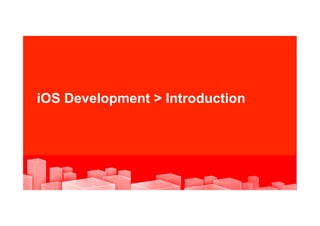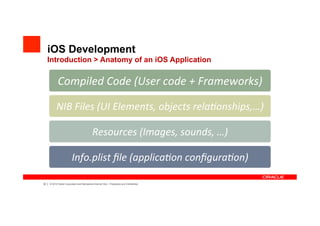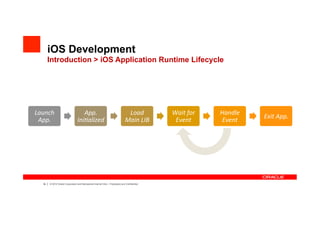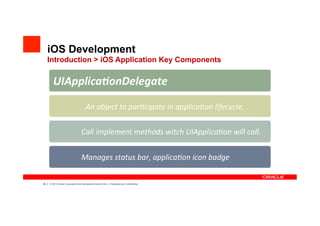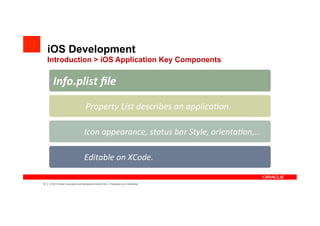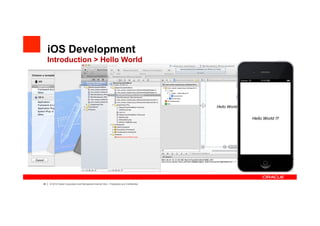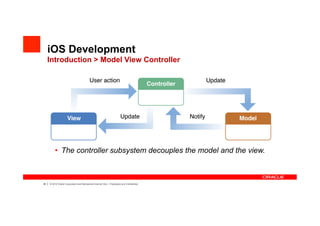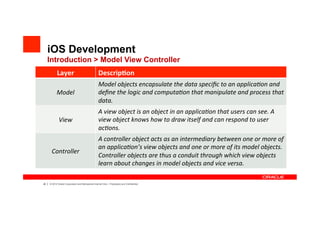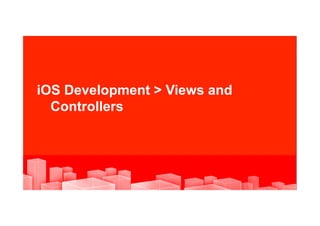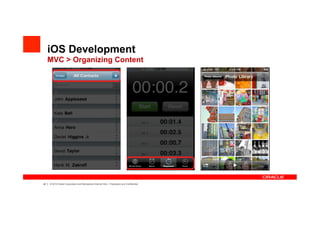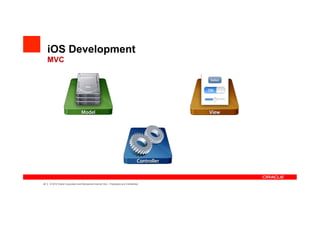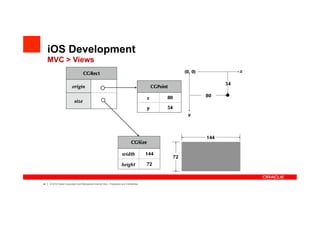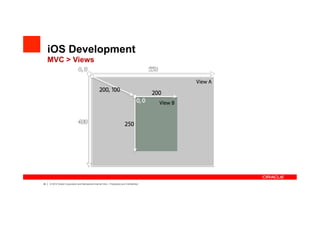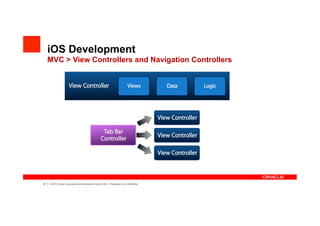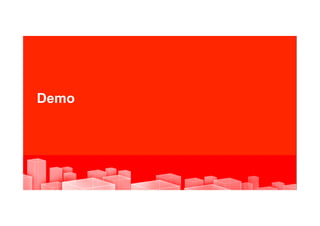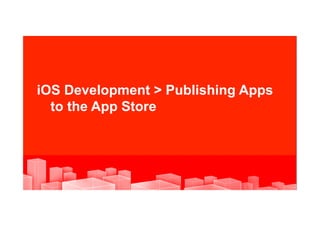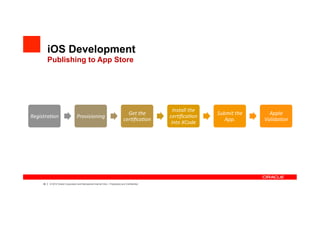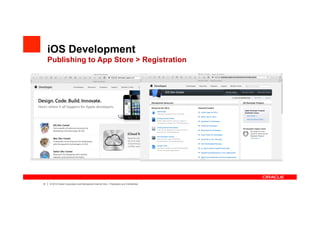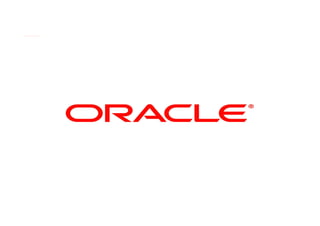Oracle master class_ios_20121019_v1
- 1. 1 | ? 2012 Oracle Corporation and Mercadona Internal Only ¨C Proprietary and Confidential
- 2. Introduction to iOS Application Development Architecture overview and development principles Juan Luis Buenosvinos Enterprise Architect 2 | juan.buenosvinos.zamora@oracle.com ? 2012 Oracle Corporation and Mercadona Internal Only ¨C Proprietary and Confidential
- 3. Agenda ?? Introduction ?? iOS History ?? iOS Architecture ?? iOS Development ?? Demo ?? In Conclusion 3 | ? 2012 Oracle Corporation and Mercadona Internal Only ¨C Proprietary and Confidential
- 4. Introduction 4 | ? 2012 Oracle Corporation and Mercadona Internal Only ¨C Proprietary and Confidential 4 EWC REPRESENTATIVES COPY
- 5. Introduction Introduction 5 | ? 2012 Oracle Corporation and Mercadona Internal Only ¨C Proprietary and Confidential
- 6. iOS History 6 | ? 2012 Oracle Corporation and Mercadona Internal Only ¨C Proprietary and Confidential 6 EWC REPRESENTATIVES COPY
- 7. iOS History iOS versions > Timeline iOS ?1 ? iOS ?2 ? iOS ?3 ? iOS ?4 ? iOS ?5 ? iOS ?6 ? 7 | ? 2012 Oracle Corporation and Mercadona Internal Only ¨C Proprietary and Confidential
- 8. iOS History iOS History > Timeline Version ? Released ? Device ? Key ?Func4onality ? Core ?iOS ?UI ? Mul4touch ?gestures ? Mobile ?Safari ? iOS ?1.0 ? 06 ?/ ?2007 ? iPhone ?2G ? iPod ? Visual ?Voicemail ? Maps ? iTunes ?Sync ? iTunes ?Wi-?©\Fi ?Music ?Store ? iPhone ?2G ? iOS ?1.1 ? 09 ?/ ?2007 ? iPod ?Touch ?compa4bility ? iPod ?Touch ?1st ?Gen. ? 8 | ? 2012 Oracle Corporation and Mercadona Internal Only ¨C Proprietary and Confidential
- 9. iOS History iOS History > Timeline Version ? Released ? Device ? Key ?Func4onality ? Na4ve ?3rd-?©\party ?apps ? iPhone ?3G ? App ?Store ? iOS ?2.0 ? 07/2008 ? iPhone ?2G ? MicrosoK ?Exchange ?support ? MobileMe ? iPod ?Touch ?1st ?Gen. ? Contact ?Search ? iPhone ?3G ? BaOery ?life ?and ?speed ??xes ? iPhone ?2G ? iOS ?2.1 ? 09/2008 ? iTunes ?Genius ?playlists ? iPod ?Touch ?2nd ?Gen. ? iPod ?Touch ?1st ?Gen. ? Dropped ?call ??xes ? 9 | ? 2012 Oracle Corporation and Mercadona Internal Only ¨C Proprietary and Confidential
- 10. iOS History iOS History > Timeline Version ? Released ? Device ? Key ?Func4onality ? iPhone ?3G ? Google ?street ?view ? iOS ?2.2 ? 11/2008 ? iPhone ?2G ? Podcast ?downloads ? iPod ?Touch ?1st ?Gen. ? Cut, ?copy, ?paste ? iPhone ?3G ? Voice ?Control ? MMS ? iPhone ?2G ? Spotlight ?search ? iOS ?3.0 ? 06/2009 ? Push ?no4?ca4ons ? iPod ?Touch ?2nd ?Gen. ? USB ?& ?Bluetooth ?tethering ? Landscape ?keyboard ? iPod ?Touch ?1st ?Gen. ? Find ?my ?iPhone ? 10 | ? 2012 Oracle Corporation and Mercadona Internal Only ¨C Proprietary and Confidential
- 11. iOS History iOS History > Timeline Version ? Released ? Device ? Key ?Func4onality ? iPhone ?3GS ? Genius ?features ? iPhone ?3G ? Ringtone ?downloads ? iPhone ?2G ? iOS ?3.1 ? 09/2009 ? iPod ?Touch ?3rd ?Gen. ? Remote ?lock ? iPod ?Touch ?2nd ?Gen. ? Voice ?Control ?over ?Bluetooth ? iPod ?Touch ?1st ?Gen. ? 11 | ? 2012 Oracle Corporation and Mercadona Internal Only ¨C Proprietary and Confidential
- 12. iOS History iOS History > Timeline Version ? Released ? Device ? Key ?Func4onality ? Support ?for ?iPad ?resolu4on ? New ?app ?views ?for ?iPad ? iOS ?3.2 ? 04/2010 ? iPad ? Loca4on ?based ?on ?Apple ?data ? Bluetooth ?keyboard ?support ? iBooks ? iPhone ?4 ? Mul4tasking ? Home ?screen ?folders ? iPhone ?3GS ? FaceTime ?video ?chat ? iOS ?4.0 ? 06/2012 ? iPhone ?3G ? Uni?ed ?email ?inbox ? Threaded ?email ?messages ? iPod ?Touch ?3rd ?Gen ? Re4na ?Display ?support ? iPod ?Touch ?2nd ?Gen ? iAd ?support ? 12 | ? 2012 Oracle Corporation and Mercadona Internal Only ¨C Proprietary and Confidential
- 13. iOS History iOS History > Timeline Version ? Released ? Device ? Key ?Func4onality ? iPhone ?4S ? Siri ? iPhone ?3GS, ? No4?ca4on ?Center ? iPad ? PC-?©\free ? iOS ?5.0 ? 10/2011 ? iPad ?2 ? iTunes ?Wi-?©\Fi ?Sync ? iPod ?Touch ?4th ?Gen, ? iMessage ? iPod ?Touch ?3rd ?Gen ? iCloud ? 13 | ? 2012 Oracle Corporation and Mercadona Internal Only ¨C Proprietary and Confidential
- 14. iOS History iOS History > Timeline Version ? Released ? Device ? Key ?Func4onality ? iPhone ?5 ? Homegrown ?Maps ?and ?turn-?©\by-?©\turn ? naviga4on ? iPhone ?4S ? Siri ?enhancements ? iPhone ?4 ? Facebook ?integra4on ? iOS ?6.0 ? Fall ?2012 ? iPhone ?3GS ? Passbook ? iPad ?3 ? iCloud ?Tabs ? iPad ?2 ? Mail ?enhancements ? iPod ?Touch ?4th ?Gen ? FaceTime ?over ?cellular ? 14 | ? 2012 Oracle Corporation and Mercadona Internal Only ¨C Proprietary and Confidential
- 15. iOS Architecture 15 | ? 2012 Oracle Corporation and Mercadona Internal Only ¨C Proprietary and Confidential 15 EWC REPRESENTATIVES COPY
- 16. iOS Architecture iOS Architecture > Introduction OS ?X ? iOS ? Cocoa ? Cocoa ?Touch ? Media ? Media ? Core ?Services ? Core ?Services ? Core ?OS ? Core ?OS ? 16 | ? 2012 Oracle Corporation and Mercadona Internal Only ¨C Proprietary and Confidential
- 17. iOS Architecture iOS Architecture > Core OS Core ?OS ? Manage ?the ?virtual ?memory ?system, ?threads, ?the ??le ?system, ?the ?network, ?and ? inter-?©\process ?communica4on ?with ?the ?frameworks ?in ?the ?Core ?OS ?layer. ?This ? layer ?encompasses ?the ?kernel ?environment, ?drivers, ?and ?basic ?interfaces ?of ?iO. ? Power ? OS ?X ?Kernel ? Mach ?3.0 ? BSD ? Sockets ? Security ? Management ? Keychain ? Cer??cates ? File ?System ? Bonjour ? 17 | ? 2012 Oracle Corporation and Mercadona Internal Only ¨C Proprietary and Confidential
- 18. iOS Architecture iOS Architecture > Core Services Core ?Services ? Gain ?access ?to ?fundamental ?iOS ?services ?with ?the ?frameworks ?in ?the ?Core ? Services ?layer. ?With ?these ?services, ?access ??les, ?low-?©\level ?data ?types, ?Bonjour ? services, ?network ?sockets, ?and ?more. ?Use ?the ?frameworks ?in ?this ?layer ?if ?those ? in ?the ?Cocoa ?Touch ?and ?Media ?layers ?aren't ?su?cient ?for ?your ?needs. ? Collec?ons ? Core ?Loca?on ? Address ?Book ? Net ?Services ? Networking ? Threading ? File ?Access ? Preferences ? SQLite ? URL ?u?li?es ? 18 | ? 2012 Oracle Corporation and Mercadona Internal Only ¨C Proprietary and Confidential
- 19. iOS Architecture iOS Architecture > Media Media ? Create ?the ?best ?mul4media ?experience ?available ?on ?a ?mobile ?device ?with ?the ? frameworks ?in ?the ?Media ?layer. ? Core ?Audio ? JPG, ?PNG, ?TIFF ? OpenAL ? PDF ? Audio ?Mixing ? Quartz ? Audio ? Core ? Video ? OpenGL ?ES ? (2D) ? Recording ? Anima?on ? Playback ? 19 | ? 2012 Oracle Corporation and Mercadona Internal Only ¨C Proprietary and Confidential
- 20. iOS Architecture iOS Architecture > Cocoa Touch Cocoa ?Touch ? Implement ?a ?graphical, ?event-?©\driven ?applica4on ?in ?iOS ?with ?the ?frameworks ?in ? the ?Cocoa ?Touch ?Layer. ?In ?addi4on, ?use ?the ?frameworks ?in ?this ?layer ?to ?access ? key ?device ?features, ?such ?as ?user ?contacts. ? Mul?-?©\ Mul?-?©\Touch ? Touch ? Accelerometer ? View ?Hierarchy ? Localiza?on ? Events ? Controls ? Web ? Alerts ? People ?Picker ? Image ?Picker ? Camera ? View ? 20 | ? 2012 Oracle Corporation and Mercadona Internal Only ¨C Proprietary and Confidential
- 21. iOS Development 21 | ? 2012 Oracle Corporation and Mercadona Internal Only ¨C Proprietary and Confidential 21 EWC REPRESENTATIVES COPY
- 22. iOS Development > Key Concepts 22 | ? 2012 Oracle Corporation and Mercadona Internal Only ¨C Proprietary and Confidential 22 EWC REPRESENTATIVES COPY
- 23. iOS Development Development Key Concepts Key ?Element ? Descrip4on ? Tools ? XCode ? Interface ?Builder ? Frameworks ? Founda?on ? UIKit ? Language ? Objec?ve-?©\C ? 23 | ? 2012 Oracle Corporation and Mercadona Internal Only ¨C Proprietary and Confidential
- 24. iOS Development Key Concepts > Language > Objective-C Main ?Characteris4cs ? Superset ?of ?C ?(Can ?be ?mixed ?with ?C ?and ?C++) ? Single ?inheritance ? Categories ?de?ne ?behavior ?across ?classes ? Dynamic ?run?me ? Object ?Messaging ? Class ?De?ni?on ? Proper?es ? New ?Types ? ? Enumera?on ? (Anonymous ?classes, ?Class, ?Selector) ? 24 | ? 2012 Oracle Corporation and Mercadona Internal Only ¨C Proprietary and Confidential
- 25. iOS Development Key Concepts > Language > Objective-C Extension ? Source ?Type ? Header ??les. ?Header ??les ?contain ?class, ?type, ?func?on, ?and ? .h ? constant ?declara?ons. ? Source ??les. ?This ?is ?the ?typical ?extension ?used ?for ?source ? .m ? ?les ?and ?can ?contain ?both ?Objec?ve-?©\C ?and ?C ?code. ? Source ??les. ?A ?source ??le ?with ?this ?extension ?can ?contain ?C+ + ?code ?in ?addi?on ?to ?Objec?ve-?©\C ?and ?C ?code. ?This ?extension ? .mm ? should ?be ?used ?only ?if ?you ?actually ?refer ?to ?C++ ?classes ?or ? features ?from ?your ?Objec?ve-?©\C ?code. ? 25 | ? 2012 Oracle Corporation and Mercadona Internal Only ¨C Proprietary and Confidential
- 26. iOS Development Key Concepts > Language > Objective-C 26 | ? 2012 Oracle Corporation and Mercadona Internal Only ¨C Proprietary and Confidential
- 27. iOS Development Key Concepts > Language > Objective-C 27 | ? 2012 Oracle Corporation and Mercadona Internal Only ¨C Proprietary and Confidential
- 28. iOS Development Key Concepts > Language > Objective-C 28 | ? 2012 Oracle Corporation and Mercadona Internal Only ¨C Proprietary and Confidential
- 29. iOS Development Key Concepts > Frameworks 29 | ? 2012 Oracle Corporation and Mercadona Internal Only ¨C Proprietary and Confidential
- 30. iOS Development Key Concepts > Tools > XCode 30 | ? 2012 Oracle Corporation and Mercadona Internal Only ¨C Proprietary and Confidential
- 31. iOS Development Key Concepts > Tools > Instruments 31 | ? 2012 Oracle Corporation and Mercadona Internal Only ¨C Proprietary and Confidential
- 32. iOS Development > Introduction 32 | ? 2012 Oracle Corporation and Mercadona Internal Only ¨C Proprietary and Confidential 32 EWC REPRESENTATIVES COPY
- 33. iOS Development Introduction > Anatomy of an iOS Application Compiled ?Code ?(User ?code ?+ ?Frameworks) ? NIB ?Files ?(UI ?Elements, ?objects ?rela?onships,ˇ) ? Resources ?(Images, ?sounds, ?ˇ) ? Info.plist ??le ?(applica?on ?con?gura?on) ? 33 | ? 2012 Oracle Corporation and Mercadona Internal Only ¨C Proprietary and Confidential
- 34. iOS Development Introduction > iOS Application Runtime Lifecycle Launch ? App. ? Load ? Wait ?for ? Handle ? Exit ?App. ? App. ? Ini?alized ? Main ?LIB ? Event ? Event ? 34 | ? 2012 Oracle Corporation and Mercadona Internal Only ¨C Proprietary and Confidential
- 35. iOS Development Introduction > iOS Application Key Components ?Single ?instance ?of ?UIApplica2on ?(Singleton ?Pa5ern ?/ ?UIKit ?Framework) ? ?Orchestrates ?the ?lifecycle ?of ?an ?applica?on. ? ?Dispatches ?events ? ?Manages ?status ?bar, ?applica?on ?icon ?badge ? ?Delega?on ?to ?perform ?applica?on-?©\speci?c ?behavior ? 35 | ? 2012 Oracle Corporation and Mercadona Internal Only ¨C Proprietary and Confidential
- 36. iOS Development Introduction > iOS Application Key Components UIApplica2onDelegate ? ?An ?object ?to ?par?cipate ?in ?applica?on ?lifecycle. ? ?Call ?implement ?methods ?witch ?UIApplica?on ?will ?call. ? ? ?Manages ?status ?bar, ?applica?on ?icon ?badge ? 36 | ? 2012 Oracle Corporation and Mercadona Internal Only ¨C Proprietary and Confidential
- 37. iOS Development Introduction > iOS Application Key Components Info.plist ??le ? ?Property ?List ?describes ?an ?applica?on. ? ?Icon ?appearance, ?status ?bar ?Style, ?orienta?on,ˇ ? ?Editable ?on ?XCode. ? 37 | ? 2012 Oracle Corporation and Mercadona Internal Only ¨C Proprietary and Confidential
- 38. iOS Development Introduction > Hello World 38 | ? 2012 Oracle Corporation and Mercadona Internal Only ¨C Proprietary and Confidential
- 39. iOS Development Introduction > Model View Controller ?? The controller subsystem decouples the model and the view. 39 | ? 2012 Oracle Corporation and Mercadona Internal Only ¨C Proprietary and Confidential
- 40. iOS Development Introduction > Model View Controller Layer ? Descrip4on ? Model ?objects ?encapsulate ?the ?data ?speci?c ?to ?an ?applica?on ?and ? Model ? de?ne ?the ?logic ?and ?computa?on ?that ?manipulate ?and ?process ?that ? data. ? ? A ?view ?object ?is ?an ?object ?in ?an ?applica?on ?that ?users ?can ?see. ?A ? View ? view ?object ?knows ?how ?to ?draw ?itself ?and ?can ?respond ?to ?user ? ac?ons. ? ? A ?controller ?object ?acts ?as ?an ?intermediary ?between ?one ?or ?more ?of ? an ?applica?onˇŻs ?view ?objects ?and ?one ?or ?more ?of ?its ?model ?objects. ? Controller ? Controller ?objects ?are ?thus ?a ?conduit ?through ?which ?view ?objects ? learn ?about ?changes ?in ?model ?objects ?and ?vice ?versa. ? 40 | ? 2012 Oracle Corporation and Mercadona Internal Only ¨C Proprietary and Confidential
- 41. iOS Development > Views and Controllers 41 | ? 2012 Oracle Corporation and Mercadona Internal Only ¨C Proprietary and Confidential 41 EWC REPRESENTATIVES COPY
- 42. iOS Development MVC > Organizing Content 42 | ? 2012 Oracle Corporation and Mercadona Internal Only ¨C Proprietary and Confidential
- 43. iOS Development MVC 43 | ? 2012 Oracle Corporation and Mercadona Internal Only ¨C Proprietary and Confidential
- 44. iOS Development MVC > Views 44 | ? 2012 Oracle Corporation and Mercadona Internal Only ¨C Proprietary and Confidential
- 45. iOS Development MVC > Views 45 | ? 2012 Oracle Corporation and Mercadona Internal Only ¨C Proprietary and Confidential
- 46. iOS Development MVC > Creation Views 46 | ? 2012 Oracle Corporation and Mercadona Internal Only ¨C Proprietary and Confidential
- 47. iOS Development MVC > View Controllers and Navigation Controllers 47 | ? 2012 Oracle Corporation and Mercadona Internal Only ¨C Proprietary and Confidential
- 48. Demo 48 | ? 2012 Oracle Corporation and Mercadona Internal Only ¨C Proprietary and Confidential 48 EWC REPRESENTATIVES COPY
- 49. iOS Development > Publishing Apps to the App Store 49 | ? 2012 Oracle Corporation and Mercadona Internal Only ¨C Proprietary and Confidential 49 EWC REPRESENTATIVES COPY
- 50. iOS Development Publishing to App Store Install ?the ? Get ?the ? Submit ?the ? Apple ? Registra?on ? Provisioning ? cer??ca?on ? cer??ca?on ? App. ? Valida?on ? into ?XCode ? 50 | ? 2012 Oracle Corporation and Mercadona Internal Only ¨C Proprietary and Confidential
- 51. iOS Development Publishing to App Store > Registration 51 | ? 2012 Oracle Corporation and Mercadona Internal Only ¨C Proprietary and Confidential
- 52. In Conclusion 52 | ? 2012 Oracle Corporation and Mercadona Internal Only ¨C Proprietary and Confidential 52 EWC REPRESENTATIVES COPY
- 53. 53 | ? 2012 Oracle Corporation and Mercadona Internal Only ¨C Proprietary and Confidential

